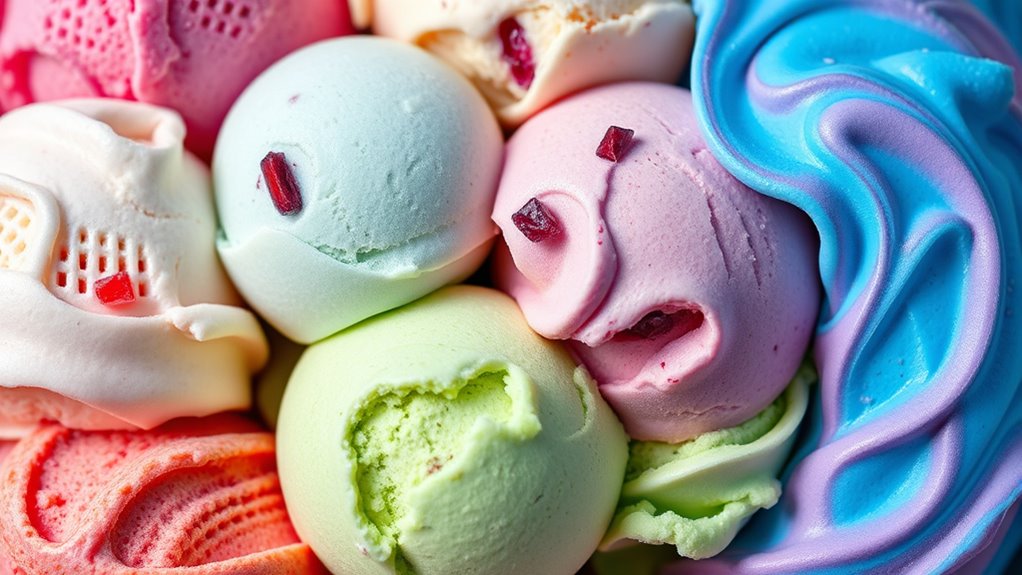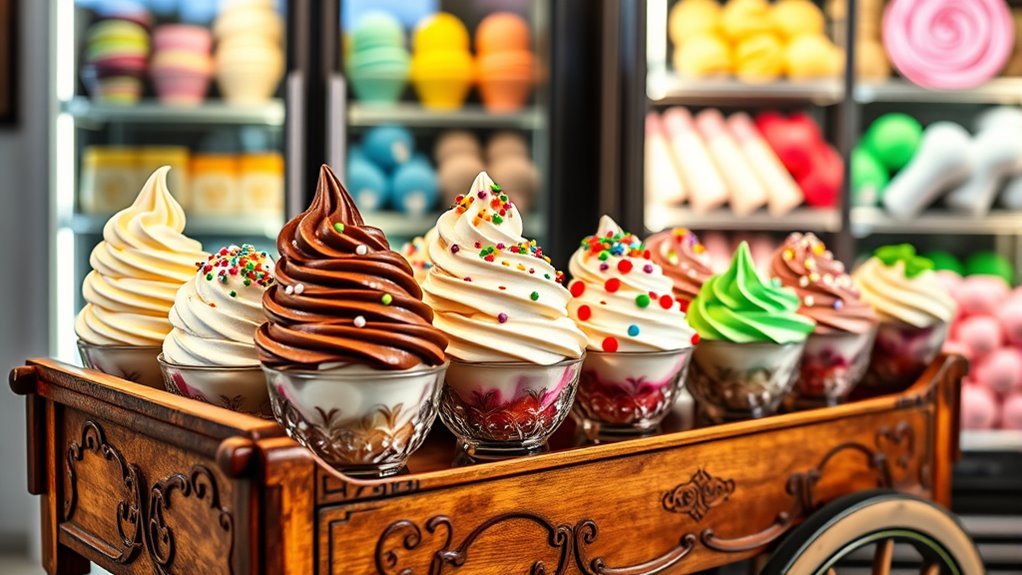The evolution of ice cream flavors takes you from the simplicity of vanilla’s origin to today’s inventive and diverse creations. Over time, flavors have shifted from basic staples to complex combinations inspired by cultural exchange and sustainability efforts. Natural ingredients and ethical sourcing now play a key role in flavor development, reflecting both environmental concerns and global influences. If you keep exploring, you’ll discover how tradition and innovation continue to shape this sweet journey.
Key Takeaways
- Ice cream flavors have evolved from simple vanilla and chocolate to inventive, complex combinations influenced by global culinary trends.
- Cultural exchange introduces diverse ingredients like matcha, saffron, and dulce de leche, enriching flavor options.
- Sustainability efforts promote natural, ethically sourced ingredients, supporting local farmers and environmental preservation.
- Modern flavors reflect cultural appreciation and responsible sourcing, blending tradition with innovation.
- The evolution turns ice cream into a symbol of environmental consciousness and cultural diversity, transforming the tasting experience.

Have you ever wondered how ice cream flavors have changed over time? It’s fascinating to see how this beloved treat has evolved from simple, classic flavors to inventive, sometimes wild combinations. One key factor in this evolution is the growing emphasis on sustainable flavor sourcing. More producers today are prioritizing ingredients that are eco-friendly and ethically harvested. Instead of relying on synthetic or heavily processed flavorings, many brands now seek out natural sources that support local farmers and reduce environmental impact. For example, instead of artificial vanilla, some companies use sustainably farmed vanilla beans from regions that practice environmentally conscious agriculture. This shift not only helps preserve ecosystems but also enhances the authenticity of flavors, offering consumers a richer, more genuine experience. As awareness around sustainability increases, you’ll notice more ice cream makers exploring innovative ways to source ingredients responsibly, which influences the palette of flavors available today.
Cultural influence on flavors plays an equally significant role in the evolution of ice cream. Over time, as societies have become more interconnected, flavors from around the world have found their way into our freezers. You might find matcha from Japan, cardamom from the Middle East, or dulce de leche from Latin America, each bringing a piece of their culture into your bowl. These influences help diversify the traditional lineup of vanilla, chocolate, and strawberry, making ice cream a reflection of global culinary traditions. Furthermore, regional ingredients and local tastes have inspired unique creations. For instance, Scandinavian-style lingonberry or Indian saffron flavors have gained popularity, showcasing how cultural exchange enriches the ice cream landscape. This blending of traditions encourages you to explore new tastes and appreciate the cultural stories behind each flavor. It also pushes artisans and brands to experiment with ingredients that challenge conventional expectations, leading to more adventurous and exciting options.
As you observe the progression from simple to complex flavors, it’s clear that both sustainable sourcing and cultural influence are reshaping how ice cream evolves. These factors push creators to be more innovative, responsible, and respectful of cultural heritage. So, next time you indulge in a scoop, think about the journey those flavors have taken: from responsible sourcing farms to recipes inspired by distant lands. The world of ice cream is no longer just about satisfying a sweet craving but also about supporting sustainability and celebrating diversity. This dynamic evolution makes every scoop a small act of cultural appreciation and environmental consciousness, reflecting how ice cream continues to adapt and thrive in a changing world.
Frequently Asked Questions
How Did Vanilla Become the Most Popular Ice Cream Flavor?
You might wonder how vanilla became the top ice cream flavor. Vanilla bean origins trace back to Central America, and its natural, creamy taste appeals to many. Flavor popularity factors include its versatility, subtle sweetness, and ability to complement other ingredients. Its long-standing reputation and widespread availability helped solidify vanilla as the favorite, making it a timeless choice for ice cream enthusiasts around the world.
What Are the Rarest Historical Ice Cream Flavors?
You might find it fascinating that some of the rarest historical ice cream flavors feature exotic ingredient combinations, like rosewater and saffron or lavender and honey. These historical flavor innovations showcased unique tastes from different cultures. Back then, ice cream makers experimented with unusual ingredients, creating limited-edition treats that are now incredibly rare. Their creative spirit laid the groundwork for today’s wild and inventive flavors, making these historical gems truly special and hard to find.
How Do Food Trends Influence New Ice Cream Flavors?
Food trends heavily influence new ice cream flavors through social media influence, inspiring you to try novel ingredient combinations. When popular influencers or viral posts showcase unique flavors, you’re more likely to seek out or create similar treats. This buzz encourages ice cream makers to experiment with unexpected ingredients, making flavors more exciting and diverse. As a result, social media shapes the ever-evolving landscape of ice cream, pushing boundaries and satisfying your craving for innovation.
Are There Regional Differences in Traditional Ice Cream Flavors?
Oh, you’d think everyone’s tastes would blend into one flavor, right? But no, regional preferences and cultural influences shape traditional ice cream flavors differently across the world. In Italy, gelato reigns supreme, while in Japan, matcha is a favorite. These regional differences reflect local ingredients, history, and culture, proving that ice cream isn’t just a treat — it’s a delicious reflection of your surroundings.
What Are the Health Impacts of Unusual Ice Cream Ingredients?
You might wonder about the health impacts of unusual ice cream ingredients. If you have dairy allergies, these creative flavors could trigger reactions or upset your stomach. Additionally, many use artificial additives and preservatives that may cause allergies, hyperactivity, or other health issues over time. It’s wise to check ingredient labels and enjoy such treats in moderation, especially if you’re sensitive to certain ingredients or trying to maintain a healthy diet.
Conclusion
So, here you are, savoring all these wild, modern flavors, thinking vanilla’s simple charm is long gone. Ironically, it’s become the classic that paved the way for today’s crazy creations. Who knew that behind all the colorful, bizarre concoctions, a humble vanilla scoop still reigns supreme? Maybe sometimes, the simplest flavor really is the most revolutionary, proving that even in a world of chaos, tradition can still steal the show—sweet, surprising, and delightfully timeless.










